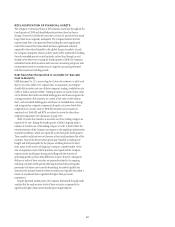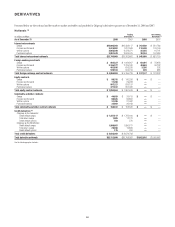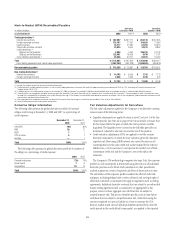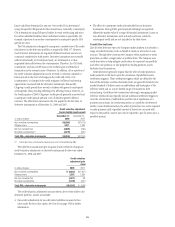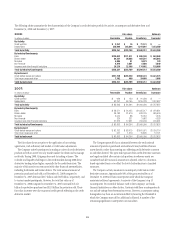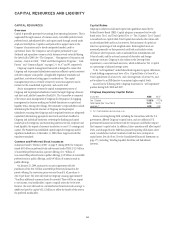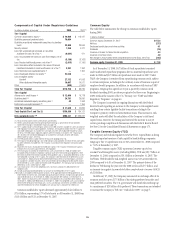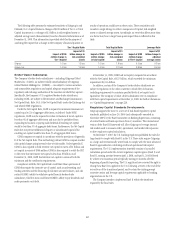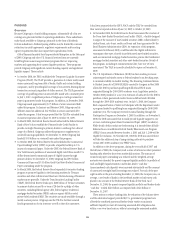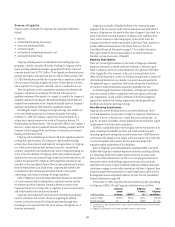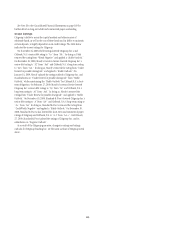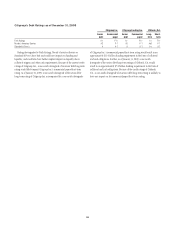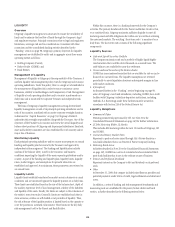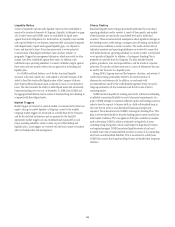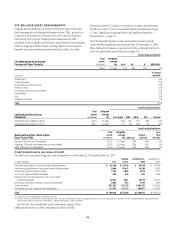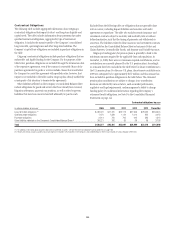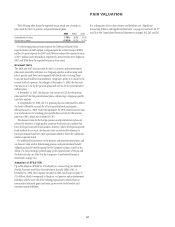Citibank 2008 Annual Report Download - page 103
Download and view the complete annual report
Please find page 103 of the 2008 Citibank annual report below. You can navigate through the pages in the report by either clicking on the pages listed below, or by using the keyword search tool below to find specific information within the annual report.
The following table presents the estimated sensitivity of Citigroup’s and
Citibank, N.A.’s Capital Ratios to changes of $100 million of Tier 1 or Total
Capital (numerator), or changes of $1 billion in risk-weighted assets or
adjusted average assets (denominator) based on financial information as of
December 31, 2008. This information is provided solely for the purpose of
analyzing the impact that a change in the Company’s financial position or
results of operations could have on these ratios. These sensitivities only
consider a single change to either a component of Capital, risk-weighted
assets or adjusted average assets. Accordingly, an event that affects more than
one factor may have a larger basis-point impact than is reflected in this
table.
Tier 1 Capital Ratio Total Capital Ratio Leverage Ratio
Impact of $100
million change in
Tier 1 Capital
Impact of $1
billion change in
risk-weighted
assets
Impact of $100
million change
in total capital
Impact of $1
billion change in
risk-weighted
assets
Impact of $100
million change
in Tier 1 Capital
Impact of $1
billion change in
adjusted
average assets
Citigroup 1.0 bps 1.2 bps 1.0 bps 1.6 bps 0.5 bps 0.3 bps
Citibank, N.A. 1.4 bps 1.4 bps 1.4 bps 2.1 bps 0.8 bps 0.5 bps
Broker-Dealer Subsidiaries
The Company’s broker-dealer subsidiaries—including Citigroup Global
Markets Inc. (CGMI), an indirect wholly owned subsidiary of Citigroup
Global Markets Holdings Inc. (CGMHI)—are subject to various securities
and commodities regulations and capital adequacy requirements of the
regulatory and exchange authorities of the countries in which they operate.
Specifically, the Company’s U.S.-registered broker-dealer subsidiaries,
including CGMI, are subject to the Securities and Exchange Commission’s
Net Capital Rule, Rule 15c3-1 (the Net Capital Rule) under the Exchange Act
and related NYSE regulations.
Under the Net Capital Rule, CGMI is required to maintain minimum net
capital equal to 2% of aggregate debit items, as defined. Under NYSE
regulations, CGMI may be required to reduce its business if its net capital is
less than 4% of aggregate debit items and may also be prohibited from
expanding its business or paying cash dividends if resulting net capital
would be less than 5% of aggregate debit items. Furthermore, the Net Capital
Rule does not permit withdrawal of equity or subordinated capital if the
resulting net capital would be less than 5% of aggregate debit items.
CGMI computes net capital in accordance with the provisions of Appendix
E of the Net Capital Rule. This methodology allows CGMI to compute market
risk capital charges using internal value-at-risk models. Under Appendix E,
CGMI is also required to hold tentative net capital in excess of $1 billion and
net capital in excess of $500 million. CGMI is also required to notify the SEC
in the event that its tentative net capital is less than $5 billion. As of
December 31, 2008, CGMI had tentative net capital in excess of both the
minimum and the notification requirements.
Compliance with the Net Capital Rule could limit those operations of
CGMI that require the intensive use of capital, such as underwriting and
trading activities and the financing of customer account balances, and also
restrict CGMHI’s ability to withdraw capital from its broker-dealer
subsidiaries, which in turn could limit CGMHI’s ability to pay dividends and
make payments on its debt.
At December 31, 2008, CGMI had net capital, computed in accordance
with the Net Capital Rule, of $2.5 billion, which exceeded the minimum
requirement by $1.6 billion.
In addition, certain of the Company’s broker-dealer subsidiaries are
subject to regulation in the other countries in which they do business,
including requirements to maintain specified levels of net capital or its
equivalent. The Company’s broker-dealer subsidiaries were in compliance
with their capital requirements at December 31, 2008. See further discussions
on “Capital Requirements” on page 228.
Regulatory Capital Standards Developments
Citigroup supports the move to a new set of risk-based regulatory capital
standards, published on June 26, 2004 (and subsequently amended in
November 2005) by the Basel Committee on Banking Supervision, consisting
of central banks and bank supervisors from 13 countries. The international
version of the Basel II framework will allow Citigroup to leverage internal
risk models used to measure credit, operational, and market risk exposures
to drive regulatory capital calculations.
On December 7, 2007, the U.S. banking regulators published the rules for
large banks to comply with Basel II in the U.S. These rules require Citigroup,
as a large and internationally active bank, to comply with the most advanced
Basel II approaches for calculating credit and operational risk capital
requirements. The U.S. implementation timetable consists of a parallel
calculation period under the current regulatory capital regime (Basel I) and
Basel II, starting anytime between April 1, 2008, and April 1, 2010 followed
by a three-year transition period, typically starting 12 months after the
beginning of parallel reporting. The U.S. regulators have reserved the right to
change how Basel II is applied in the U.S. following a review at the end of the
second year of the transitional period, and to retain the existing prompt
corrective action and leverage capital requirements applicable to banking
organizations in the U.S.
The Company intends to implement Basel II within the timeframe
required by the final rules.
97


